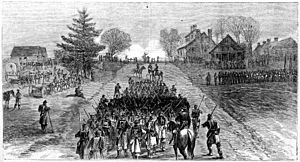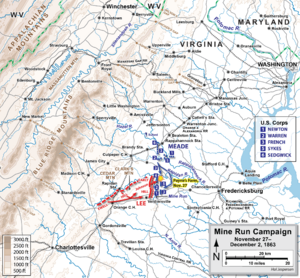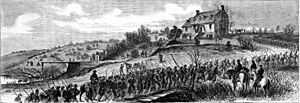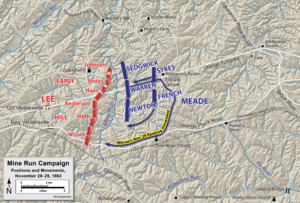Battle of Mine Run facts for kids
Quick facts for kids Battle of Mine Run |
|||||||
|---|---|---|---|---|---|---|---|
| Part of the American Civil War | |||||||
 Artillery bombardment with Warren's troops awaiting attack (from Harper's Weekly) |
|||||||
|
|||||||
| Belligerents | |||||||
| Commanders and leaders | |||||||
| George G. Meade | Robert E. Lee | ||||||
| Units involved | |||||||
| Army of the Potomac | Army of Northern Virginia | ||||||
| Strength | |||||||
| 81,000 | 48,000 | ||||||
| Casualties and losses | |||||||
| 1,653 | 629 | ||||||
The Battle of Mine Run was a military campaign during the American Civil War. It took place in Orange County, Virginia, from November 27 to December 2, 1863. This battle is also sometimes called the Mine Run Campaign, Payne's Farm, or New Hope Church.
The battle was an attempt by the Union forces to defeat the Confederate army. However, it did not lead to a clear victory for either side. The fighting involved many false starts and resulted in fewer casualties than other major battles. It marked the end of major fighting in the Eastern Theater for that year.
Contents
Why Did the Mine Run Campaign Happen?
After the Battle of Gettysburg in July 1863, Confederate General Robert E. Lee and his army went back to Virginia. The Union commander, General George G. Meade, was criticized. Many felt he did not chase Lee's army hard enough to defeat them.
General Meade then planned new attacks in Virginia for the fall. His first try was the Bristoe campaign in October and November. This campaign involved many small fights but no big wins.
In late November, Meade tried a new plan. He wanted to surprise Lee's army by moving quickly through a wooded area called the Wilderness of Spotsylvania. His goal was to attack the right side of the Confederate army. This part of Lee's army was south of the Rapidan River.
Meade had information that Lee's army was split into two parts. These parts were separated by Clark's Mountain. Lee's army had about 48,000 soldiers, while Meade's Union Army of the Potomac had 81,000. Meade planned to cross the Rapidan River where Confederate cavalry could not see them. He hoped to defeat the right side of Lee's army first. Then, he would attack the rest of the Confederate forces.
Meade wanted a fast, strong attack with his entire army. On November 25, the Union army started marching well. A thick fog on Clark's Mountain helped hide their movements from Confederate lookouts. However, one Union corps, led by General William H. French, got stuck trying to cross the river. This caused traffic jams when they tried to move their cannons. Other units were also trying to cross at the same spot.
What Happened During the Battle?
The delays meant General Meade lost the element of surprise. General Lee had time to react. Lee ordered General Jubal A. Early to march east. Early's troops soon started fighting with Union soldiers.
Meanwhile, another Confederate division, led by General Edward "Allegheny" Johnson, was also marching. They met General French's Union corps in a heavily wooded area. Johnson's 5,500 men launched a risky attack against a much larger Union force of 32,000 soldiers. This happened around 3:45 to 4:00 p.m.
Johnson's attack quickly fell apart on one side. But it was strong enough to slow down the Union advance until nightfall. Johnson's troops then retreated behind Mine Run Creek. The actual fighting lasted less than two and a half hours. Both sides suffered heavy losses. Johnson lost about 550 men, and French's corps lost about 950.
This short but bloody fight, known as the Battle of Payne's Farm, was very important. Johnson's attack stopped French's corps. This slowed the Union advance and saved Lee's army from being outflanked. If Johnson had not attacked, the Union forces could have moved behind Lee's army.
After dark, Lee pulled his army back to strong defenses along Mine Run. The next day, the Union Army moved closer to the Confederate positions. General Meade planned a big cannon attack. Then, he wanted General Gouverneur K. Warren's corps to attack in the south. An hour later, General John Sedgwick's corps would attack in the north.
Lee also planned an attack for December 2. He wanted to use a weakness he found in the Union line. But the main Union attack never happened. General Meade decided that the Confederate defenses were too strong. He called off the attack and pulled his troops back during the night of December 1-2. This ended the fall campaign. Lee was surprised to find no one left to attack the next morning.
What Was the Outcome of Mine Run?
The Union Army of the Potomac then settled into winter camps. The Battle of Mine Run was General Meade's last chance to plan a big attack in 1863. Soon after, General Ulysses S. Grant would become the overall commander of Union armies.
General Lee also regretted the outcome. He reportedly said, "I am too old to command this army. We never should have permitted those people to get away." The Confederates had hoped to repeat their victory at Chancellorsville earlier that year. But their hopes were not met. The Mine Run Campaign was Meade's final attempt in 1863 to destroy Lee's army before winter stopped military operations.
The poet Henry Wadsworth Longfellow wrote his 1863 poem "Christmas Bells" because of this battle. His son, Charles Appleton Longfellow, was badly wounded during the fighting. This poem later became the famous carol "I Heard the Bells on Christmas Day".
Preserving the Battlefield
Today, efforts have been made to save parts of the Mine Run battlefield. A historian named Theodore P. Savas helped find and map the Payne's Farm battlefield in the early 1990s. He believed earlier maps were wrong. By using metal detectors, he and Paul Sacra found many artifacts. These included bullets, buttons, and belt buckles.
Savas shared his findings with a group that preserves Civil War sites. They realized how important and well-preserved the land was. The Civil War Trust (now part of the American Battlefield Trust) and its partners later bought and protected about 690 acres of the battlefield.
Today, the battlefield has a wooded, 1.5-mile walking trail. There are historical markers along the trail that explain what happened. You can find it on Virginia highway 611, near the Zoar Baptist Church.
Images for kids







